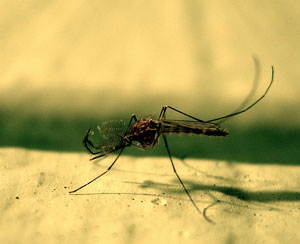Spring is the Time for a Mosquito Check of Your Yard
By Chris Williams on April 12, 2013.
 We usually don’t think about early spring being mosquito time. But, female adult mosquitoes that overwintered are out now, looking for a blood source so they can lay eggs. The mosquitoes that you see outside now actually spent the winter hidden around your home—in your shed or crawlspace, or nearby in animal burrows, under bark, in tree holes or hollow logs, or in storm sewers. These are Culex or Anopheles mosquitoes. Other types of mosquitoes spent the winter as eggs or larvae. It won’t be long, though, before these immature mosquitoes become adults. Depending on the species, adult female mosquitoes lay their eggs either in stagnant, standing water or in low areas that will become flooded after rains.
We usually don’t think about early spring being mosquito time. But, female adult mosquitoes that overwintered are out now, looking for a blood source so they can lay eggs. The mosquitoes that you see outside now actually spent the winter hidden around your home—in your shed or crawlspace, or nearby in animal burrows, under bark, in tree holes or hollow logs, or in storm sewers. These are Culex or Anopheles mosquitoes. Other types of mosquitoes spent the winter as eggs or larvae. It won’t be long, though, before these immature mosquitoes become adults. Depending on the species, adult female mosquitoes lay their eggs either in stagnant, standing water or in low areas that will become flooded after rains.
Add This to Your Spring Chore List
With spring rains coming to fill all those potholes and containers, now is a good time to check your yard for possible mosquito breeding sites. Puddles, overlooked buckets, and other sources of standing water might be easier to see now before everything is fully leafed out. It’s a good time to clean out downspouts and roof gutters so that water doesn’t collect during spring rains. Flush out ornamental ponds before they are cleaned and restocked. Now is the time to correct drainage problems and fill those low areas in your yard that always turn into puddles after rain.
It doesn’t take much water for mosquito egg-laying, less than an inch sitting in the fold of a tarp will suffice as long as the water lasts long enough for the larvae to fully develop, about 7-14 days. In your search, you may even find mosquito larvae, sometimes called “wigglers,” in the water. They hang head down in the water, using their rear end siphon tube to breathe at the surface. If disturbed, they dive for the bottom.
Sometimes mosquito breeding sites are obvious, like your son’s canoe behind the shed which now contains about 8 inches of scummy water. Sometimes you just can’t find that last bit of standing water that keeps feeding mosquitoes into your yard. We were harassed all summer by Asian tiger mosquitoes mostly in just one corner of our yard. After much searching, we finally found the standing water (and mosquito larvae) in our roof gutters where there was a low spot that didn’t drain to the downspout.
Check For These Mosquito Sources
Think about anything in your yard that could hold water after it rains. When you find a source, empty it or drain it, then remove it, or turn it upside down, or cover it. This is just a partial list of mosquito breeding sites in a typical yard: wheelbarrows or wagons, flower pots or vases, potted plant saucers, cans and buckets, old tires, wading pools, bird baths, barrels, garbage cans, tree holes, leaky faucets, tarps or plastic sheets, pet water bowls, roof gutters, clogged downspouts, canoes and boats, cesspools and storm drains.
Photo credit: Gravitywave / Foter.com / CC BY-NC-SA